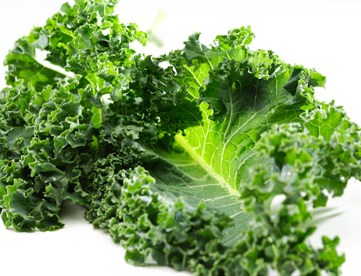Continuing on with my “alphabet of healthy foods” which I haven’t posted for a while, next in the series is K for Kale.
Kale is a green leafy plant belonging to the Brassica family, which also includes cabbage, broccoli, cauliflower, brussel sprouts and collard greens. This is a family of vegetables that should be rotated through the diet and not eaten every day – the brassica family contain natural plant chemicals called Isothyocianates which can inhibit thyroid function. If they are eaten daily in large amounts then supplemental iodine needs to be added to the diet to counteract this effect.
In Australia most often we find the curly leaf kale availabe. (below). It is a very hardy plant growing in most type of soils in a cooler climate and is naturally pest resistant, probably due to it being grown in it’s wild state and not hybridised to any great extent.
Kale is one of the most nutritious of the green leafy vegetables and is one that should be a staple part of the diet, being rotated with other greens to make the base of green smoothies, or in salads. It is high in Vitamin K which is essential for healthy blood clotting (people taking blood thinning medication need to be aware of this fact), and for building strong bones. As well as the Vitamin K content, Kale is also high in calcium making this the number one green of choice for the prevention of osteoporosis.
Kale also contains high levels of lutein and zeaxanthin which are excellent nutrients for the eyes – for the prevention of cataracts and age related macular degeneration. With powerful antioxidant and anti-inflammatory properties it really is “food as medicine!”
The Brassica family of vegetables also contain anti-cancer nutrients as well. When the cell walls of the green leaves are broken down (as in blending or chewing well) an enzyme is released which reacts with the plant alkaloids to create a chemical called Indole-3-Carbinol which can significantly inhibit the formation of many cancers and helps to convert carcinogenic oestrogen into its more protective form.
Because of the natural alkaloids that green leafy plants contain, rotating between them is essential and only eating one type of green leafy once a week is advised. The natural alkaloids are designed to repel animals from eating the whole crop of the plant and killing it off completely, so loading up on only one type of green over a period of time could lead to minor symptoms such as nausea or a repulsion for that green.
You can use Kale in Green Smoothies (see my Green Smoothie Lesson), and in salads (see my Simple Salads). It is easy to grow and being so nutritious it is one green that you would do well to become familiar with!
Leisa
![]()

4 commentsAdd comment
re: rotating
You mention: “Because of the natural alkaloids that green leafy plants contain, rotating between them is essential and only eating one type of green leafy once a week is advised.”
What if I were to eat, say, 1 kale leaf a day every day rather than 5 kale leaves a day for a week and then off kale for 5 weeks? Would eating 1 kale leaf a day be “low” enough that my body would be fine with it? In my example, the total# of kale leaves eaten is the same (35 kale leaves per 35 days.)
If indeed the wild plants produce alkaloids to avoid animals eating the entire crop, would the plants not be alright with me eating frequent, small amounts — the crop would remain abundant.
Thanks very much
Hi Daniel,
I’m not 100% sure on the ins and outs of this and you may need to contact Victoria Boutenko as she has done a lot of research on this area. What I do is use one type of leaf for three or four days in a row – and then move onto something else and leave it a week or two before going back to the first one again. I haven’t had any problems doing this – so as long as you have variety and don’t do the same thing every day for months on end, I’m sure you will be fine.
Leis
I like to dehydrate kale and munch on it periodically during the day. What other greens might hold up to dehydration and thus lend it self to dehydration ?
Hmmmm. I’m not sure! I haven’t tried to dehydrate any other greens other than Kale, but certainly, it’s worth a try with other greens. Let me know how you do!
Leisa